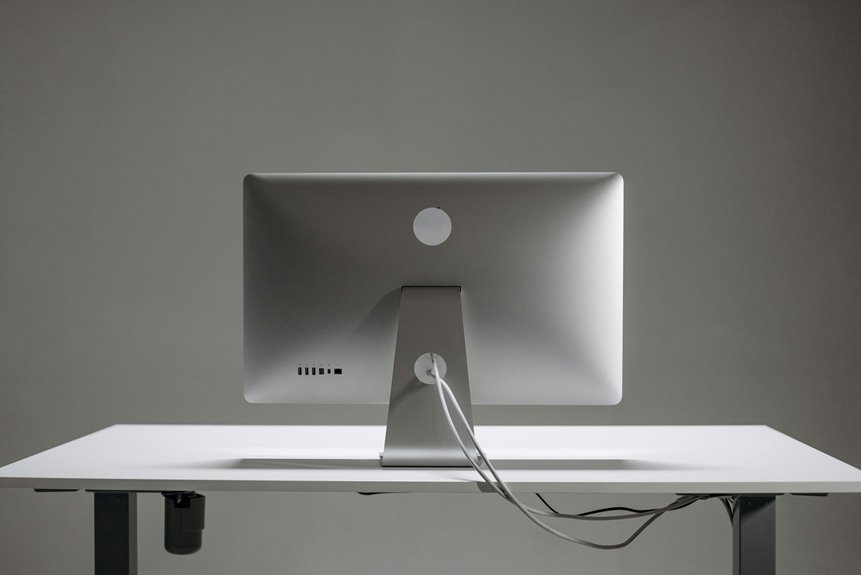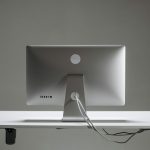To organize power cables under your desk, start by assessing the current situation. Count and identify necessary cables, then choose the right management tools like cable ties and clips. Implement routing techniques to group and secure cables, ensuring they run parallel and excess length is hidden. Label each cable for easy identification and maintain a documentation sheet. Regularly check for issues and keep your setup tidy. If you want more tips, keep exploring further!
Table of Contents
Key Takeaways
- Assess and categorize cables under your desk, separating necessary cables from those that can be discarded or replaced.
- Use cable ties or adjustable Velcro ties to bundle and secure cables, reducing clutter and tangles.
- Implement cable clips along the desk edge to keep cables organized and easily accessible.
- Label each cable with its corresponding device name for quick identification and troubleshooting.
- Regularly check and maintain your cable setup to address any wear, tangles, or new device additions.
Assess the Current Cable Situation
Before diving into organizing your power cables, it's essential to assess the current cable situation. Take a moment to examine the mess under your desk.
Check how many cables you have, their lengths, and whether they're functioning properly. Identify which cables are necessary and which aren't. It's easy to overlook unused chargers and outdated cables cluttering your space.
Next, trace the cables back to their sources. Ensure each one is connected correctly and securely. This assessment helps you prioritize which cables need immediate attention and which can be discarded.
Choose the Right Cable Management Tools
Now that you've assessed your current cable situation, it's time to choose the right cable management tools.
Start by considering cable ties; they're perfect for bundling cables together and keeping them neat. Velcro ties are adjustable and reusable, making them a great option for changing setups.
Consider using cable ties for neat bundles, while adjustable Velcro ties offer versatility for changing setups.
If you want a cleaner look, look into cable sleeves or wraps—they can conceal multiple cables in one sleek bundle.
Cable clips are handy for securing cables along the desk's edge, preventing them from falling. For larger setups, a cable management box can hide bulk and keep everything organized.
Lastly, don't forget adhesive cable organizers; they can help route cables along walls or surfaces, maintaining your workspace's tidy appearance.
Implement Cable Routing Techniques
As you dive into organizing your power cables, implementing effective cable routing techniques can significantly enhance the tidiness of your workspace. Start by grouping cables that serve the same device. Use cable ties or clips to secure them along the desk's edge, preventing tangles. Consider using cable sleeves for a sleeker look, and ensure cables run parallel to one another for a neat appearance. Finally, keep excess cable length hidden out of sight.
| Technique | Tools Needed | Benefits |
|---|---|---|
| Grouping Cables | Cable ties, clips | Reduces clutter |
| Cable Sleeves | Sleeves, scissors | Sleek appearance |
| Parallel Routing | Clips, adhesive tape | Organized setup |
| Hiding Excess | Under-desk trays | Maximizes space |
| Adjusting Length | Cable management tools | Custom fit |
Labeling and Documentation for Easy Identification
While organizing your power cables, labeling them can make identification quick and effortless. Use simple labels, such as "Monitor," "Printer," or "Router," to indicate what each cable powers. You can create labels with a label maker or write them on adhesive tags.
Color-coding is another effective method; consider using different colored labels for different categories of devices. This way, you can easily spot which cable belongs where.
Additionally, keep a documentation sheet that outlines your setup. Include details like cable types, lengths, and where they connect. Store this sheet in a convenient location, or save it digitally for easy access.
Regular Maintenance and Updates
To keep your power cable organization effective, regular maintenance and updates are essential. Start by checking your setup every few months. Look for any frayed wires, loose connections, or tangled cables that need attention. If you notice any issues, address them immediately to prevent future problems.
Consider reevaluating your cable management system as your tech needs change. If you've added new devices, adjust your organization to accommodate them. Re-label cables if necessary, ensuring everything remains clear and easy to identify.
Lastly, clean up dust and debris from your workspace to maintain a tidy environment. With consistent upkeep, you'll enjoy a clutter-free desk and a more efficient workspace, making it easier to focus on your tasks.
Frequently Asked Questions
What Tools Do I Need for Cable Management?
For effective cable management, you'll need cable ties, a cable organizer, scissors, and possibly adhesive clips. With these tools, you can keep your cables neat, reducing clutter and improving your workspace's overall appearance and functionality.
How Can I Prevent Cables From Tangling?
To prevent cables from tangling, you can use cable ties or clips to bundle and secure them. Keep cables organized by routing them along the desk's edge and avoiding excessive slack. Regularly check for tangles, too.
Are There Eco-Friendly Cable Management Options?
Absolutely, you can choose eco-friendly cable management options like bamboo cable organizers, recycled plastic clips, or biodegradable cable ties. These solutions help reduce waste while keeping your cables tidy and organized without harming the environment.
Can I Use Adhesive Solutions on All Surfaces?
You can't always use adhesive solutions on all surfaces. Some materials, like painted wood or certain plastics, might not hold well. It's best to test a small area first to ensure durability and avoid damage.
How Often Should I Check My Cable Organization?
You should check your cable organization every few months or when you notice tangling. Regular maintenance helps prevent clutter, keeps your workspace tidy, and ensures everything functions smoothly without any unnecessary distractions or hazards.




